
Now that students have easy access to artificial intelligence chatbots like Chat GPT, teachers are pondering how to prevent students from using these tools to do their work for them. Cheating seems to be easier than ever these days. English language arts teachers are especially panicked.
But, before discussing these issues, what exactly is Chat GPT and how does it work?
Chat GPT (g=generative, p=pre-trained, t=transformer) is a new artificial intelligence tool, made by the company OpenAI, that came out November 2022. Chatgpt answers questions in a conversational way. You type your question and it types back…within seconds, no matter the question.
You can ask Chat GPT to write entire essays for you and then ask followup questions. It can write poems, essays, advice, cover letters, or talk to you about pretty much any topic you want to discuss. It also responds to human feedback and will quickly give you a detailed response back. It’s a dialogue format.
College students are anonymously coming out and talking about how helpful it’s been for them when going through finals this winter. This new AI chatbot is providing new guidance to students, bloggers, and even coders that has never been seen before. It’s a free online service for these groups and the public (for now).
I highly recommend you try Chat GPT out for yourself, if you haven’t already, by clicking here.
Some are calling it the future of search engine technology, some are saying it’s the end of the essay. Some say it will make teachers’ lives a lot harder because they’ll have to do extra work to suss out plagiarized writing.
Chat GPT is blowing everyones’ minds (including mine) because of its capabilities. It’s only in beta right now and there is a clear disclaimer within the tool that it can produce inaccurate, blatantly incorrect information. It’s also been shown to produce biased and racist content, yikes. Eventually, it will be behind a paywall, making it harder for students to access it without shelling out some cash.
When I started playing with Chat GPT I felt a mixture of excitement and fear.
I was excited about the potential to improve my writing with feedback from artificial intelligence, to have a tool for getting ideas for blog posts, and to be able to produce writing samples for students. I also toyed with having it write blog posts for me, knowing full well I would absolutely never copy and paste what it produced and call it mine. It lacks my voice and personality, check it out a blog post it wrote for me here:
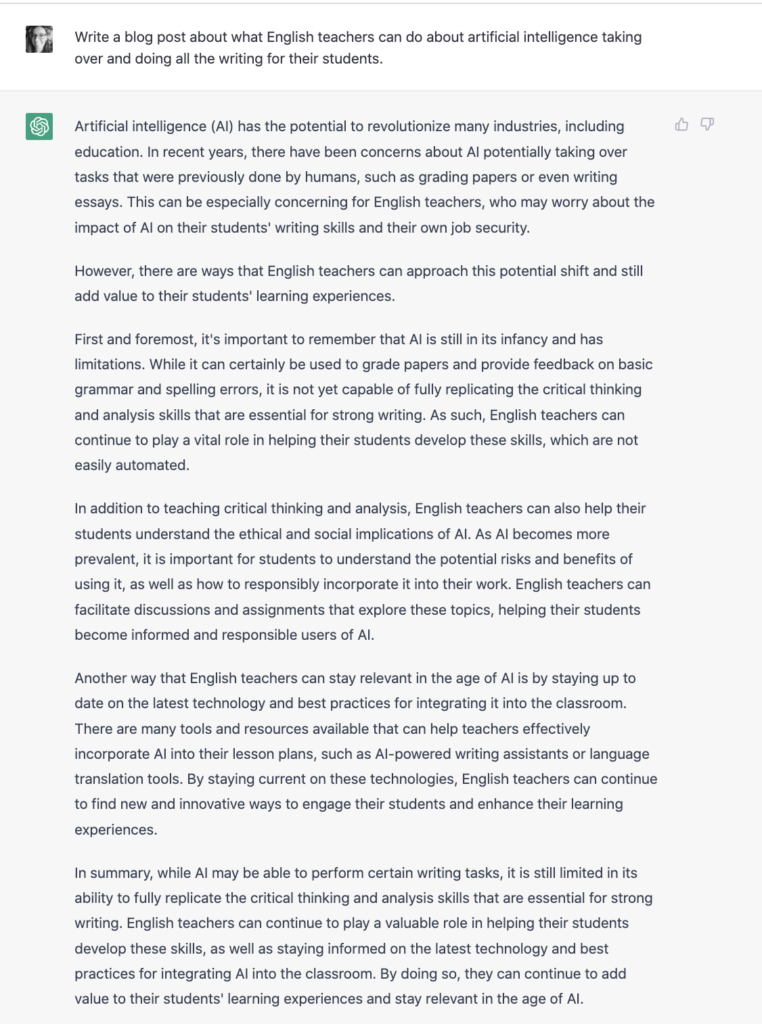
While my excitement increased, so did my fear about this type of tool in the hands of students, who might want to use it to get out of doing their work, who might be enticed to have Chat GPT write their essays, poems, and personal narratives for them.
The prospect made my head spin. I wracked my brain and the internet searching for ways to prevent plagiarism and cheating but also harness the tool to support students without hindering their thinking and learning.
I decided I needed to write a series of blog posts on this topic to try and grapple with the complexities of this new technology. Each part attempts to answer essential questions teachers are asking about artificial intelligence tools like Chat GPT.
Here are the questions I’m attempting to answer with this series:
Part 1: 7 Ways Chat GPT Will Impact Education…Positively.
Part 2: How do I prevent cheating/plagiarism when tools like this exist? (this post)
Part 3: How do I talk to my students about Chat GPT?
Now, let’s get started with part two…
Plagiarism is defined as taking someone else’s work and passing it off for your own. This is exactly what some students are now enticed to do with the writing done by ai. Teachers are rightfully worried their students will use this powerful tool to do their writing assignments and school essays for them.
The reality we need to face is that Chatgpt produces all sort of content, including essays and even answers to online exams. Teachers are going to be forced to be especially vigilant about homework assignments, assignments done on devices, canned essay writing prompts/assignments, and test questions. And take-home tests? No way. The scariest (and dare I say exciting?) part is that the capabilities of chatbots is only going to get better from here.
Here are my three best ideas for preventing cheating with the use of chatgpt and what to do if you suspect plagiarism.
Get to Know Chat GPT
After playing with the tool quite a bit, I have a feel for the type of writing it produces. The writing is very direct, formulaic, and sometimes repetitive. It feels like reading a very boring, five paragraph essay. But, with some back and forth with the chatbot, anyone could get it to produce writing worthy of college essay A+ status.
If you want to be able to identify if a student used Chat GPT (or other AI tools) to do their work, I highly recommend teachers play around with the tool to get a feel for the type of writing AIs can create.
However, super smart students may sense the robotic nature of the writing and spice it up with their own personality and maybe even integrate mistakes here and there. It’s only a matter of time before AI gets even better. so this method of preventing plagiarism is by no means foolproof.
This is exactly why we need to make sure to dedicate time to my next best idea…
Conduct On Demand Writing Assessments
On demand writing involves having students go through the entire writing process in one setting using an open ended prompt. The purpose of on demand writing prompts in the workshop classroom is to find out what students can do before teaching a unit and without help from the teacher. The resource below includes on demand writing prompts, writing samples, and assessment tools for nine different writing and reading units throughout a school year.
These on demand writing prompts are meant to inform the teacher about what mini lessons need to be taught during the upcoming unit. I usually give students the choice to either write by hand or type. The majority of my students have preferred typing because it’s much faster and they have a limited time to answer the prompt.
If you plan to have students type their writing, I’d recommend using a tool like Google forms and turning the form into a quiz.
The quiz version of Google forms allows you to restrict students from opening other tabs while taking the quiz. This way students can type their written response and you don’t have to worry about them sneaking off to use some ai tool during the on demand writing time.
Below is an example of an on demand writing assessment for an argumentative writing unit. This pre-assessment is included in the Google Drive Reading and Writing Workshop Assessment Toolkit.
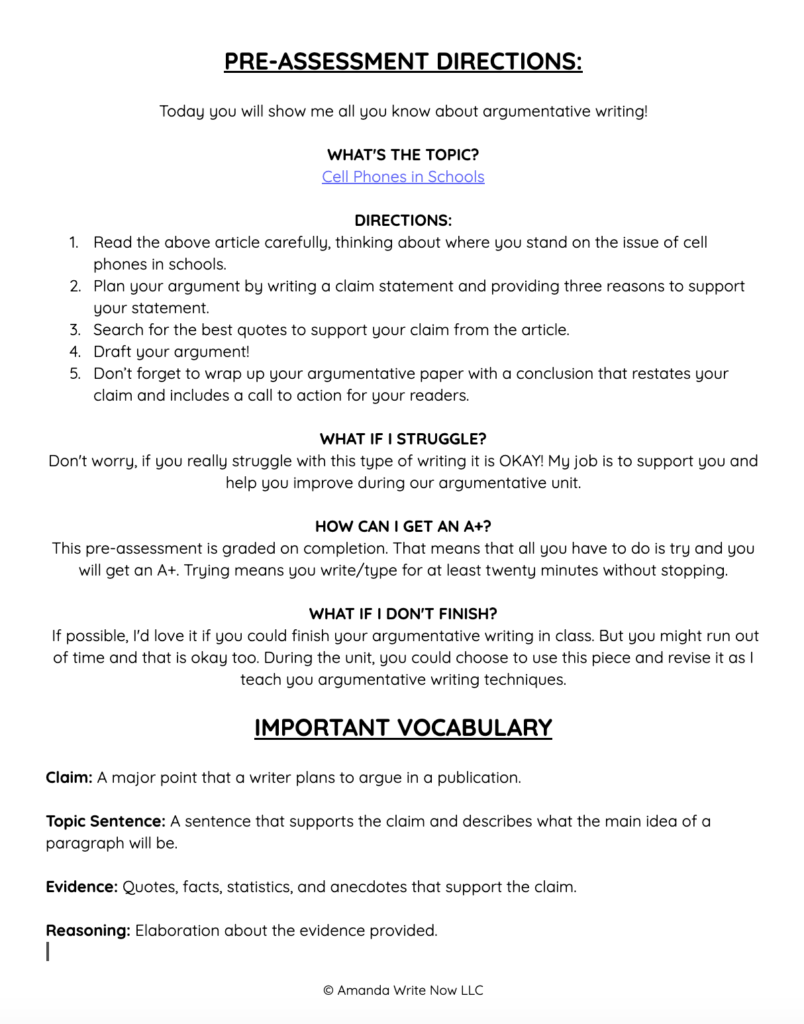
One last thing before we move on to my next best idea for preventing plagiarism…I’ve seen a lot of teachers on social media talking about how we need to be more creative about how we assess students. I agree, but for now state standardized tests still require students write essays in a test format. So, teachers are still accountable for helping students practice these essays. This is why on-demand writing assessments should have a place in our classrooms…Not only to have a sample of what students can do on their own, but also to give them much needed practice for standardized exams.
Conference with Students
Intimately knowing your students’ writing skills has become more important than ever with the advent of the large language model (AI tools that simulate the writing and speaking of humans using aggregated data from the world wide web).
Conferring with your students while they write is another way to get to know your students’ capabilities when it comes to writing. Make sure to check out the resource below to hone your conferring skills. You might also consider checking out this popular article about rethinking conferring. This article discusses how to conference with equity in mind and how to realistically be able to conference when there is only one teacher and 30+students.
Be Wary of Anti-Plagiarism Software
I think there is a place for standard plagiarism detection software like Turnitin.com or Grammarly if you suspect plagiarism. If the student plagiarized without the use of AI tools like chatgpt plagiarizing checkers are good at finding a likely match.
The primary problem with plagiarism checkers when using them with chatgpt is that the writing produced by chatgpt is completely unique and can even mimic natural language. I had chatgpt write me an essay and used Grammarly to see if it would detect any plagiarism…it detected none:
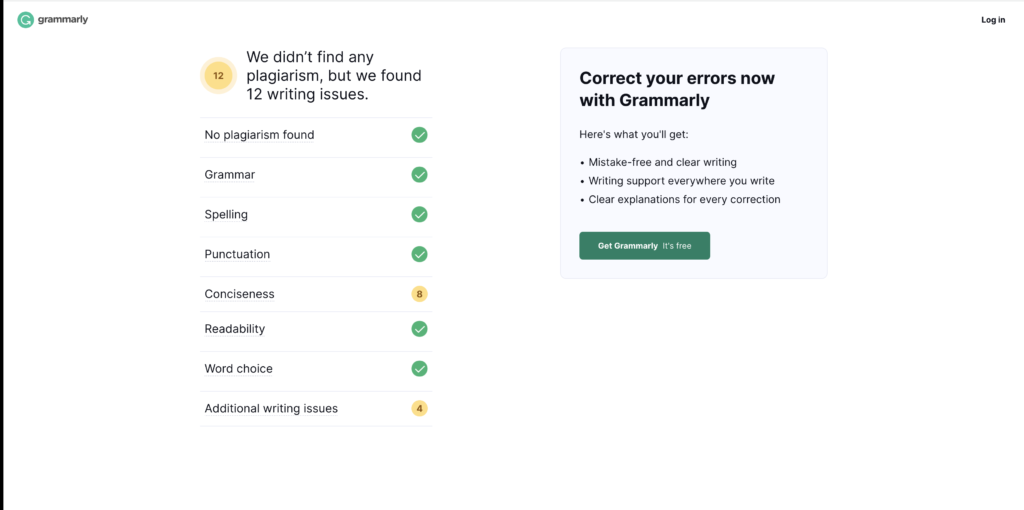
You can ask chatgpt to answer the same prompt multiple times and each time the ai will spit out different and unique answers. This use of ai chatbots is so multifaceted, it’s incredible really.
The truth is plagiarism checkers aren’t foolproof. Teachers’ intimate knowledge of their students’ writing capabilities and the capabilities of chatgpt future iterations are going to be put to the test. Getting to know students’ capabilities through on demand writing assessments and conferencing is crucial.
There is hope though! Recently a Princeton student wrote some code to identify plagiarism of ChatGPT. I tested it out and it worked! First I copied and pasted an essay about the theme of Harry Potter and the Sorcerer’s Stone written by ChatGPT. Here were the results:
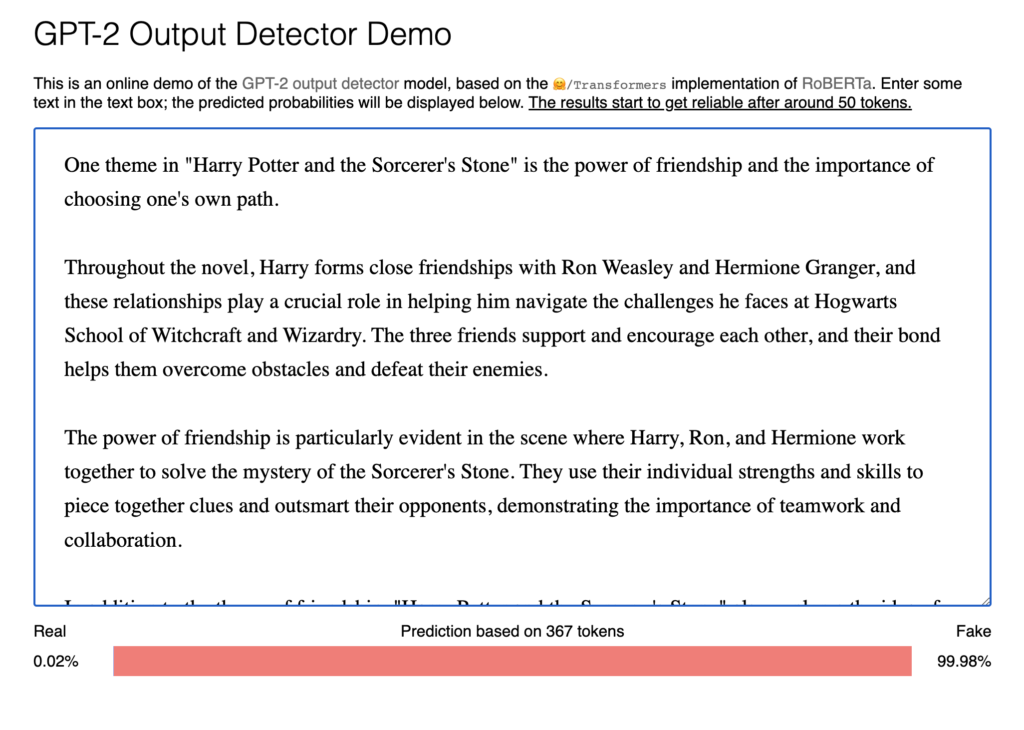
Then I copied and pasted my own essay and here were the results:

This tool was able to accurately identify which essay was plagiarized and written by ChatGPT and which essay was written by me, a human!
If You Suspect Plagiarism…
When a student turns in written work and it seems it could have been written by an AI tool like chatgpt, pull out the students’ on demand writing and compare it to what the student turned in to you.
If it’s still unclear that academic dishonesty has occurred, talk to the student. Ask the student specific questions about their writing piece, can they repeat the ideas they wrote about? Can they define specific words they utilized? Can they articulate how they came up with the ideas, the organizational structure, the specific elements like the introduction, hook, or conclusion? Can they answer follow-up questions? If after all of this you still aren’t sure if this is a case of fraudulent work, then you’ll just have to assume it was the student’s own work and keep that student on your radar moving forward.
But, what if you do catch a student plagiarizing ai? Then what?
Often students choose to cheat/plagiarize for one of these reasons:
1. They are struggling to understand the concepts you are teaching,
2. They are under a lot of pressure to do well,
3. They are experiencing stress,
4. They are experiencing peer pressure to cheat,
5. Or a combination of these is occurring.
Students who cheat or plagiarize need to be approached thoughtfully and with empathy rather than with anger and disappointment.
I realize this can be incredibly hard when a teacher feels they have been manipulated or lied to.
But, when you approach a student who has made a mistake with kindness there is the potential for a good thing to happen from a tough situation.
A bond can be created between student and teacher. When the teacher can show kindness and understanding even after the student chose to mislead them, the student may feel more willing to speak about why they did what they did. With this information the student, teacher, and possibly family of the student might even collaborate to resolve the struggles the student may be facing.
I have used this approach as a teacher before. In addition to meeting with the student one-on-one and talking to the parents, the student was given an opportunity to completely redo the assignment for full credit with additional support during study hall from me.
Some may say that was too lenient, however the student struggled so much with writing, they weren’t able to receive full credit in the end anyway.
I believe punishing students for mistakes creates a divide between students and teachers. I think this philosophy applies to parents and their children as well. Open communication, kindness, and collaborative problem solving are the best way to strengthen our connection with our children and our students.
Wrap Up
We can’t avoid new technologies like this new artificial intelligence chatbot from making its way into our classrooms. Schools do not live in a vacuum, teachers and students are impacted by all sorts of things outside of our control.
The best thing we can do is strengthen our connection and communication with students about these new developments in real time, not avoid them.
Teachers can do a number of things in response to these developments. They can facilitate open discussions about academic integrity. I’ll talk more about how to do this in part three of this series.
Teachers can facilitate on demand writing pre-assessments before starting writing units to become intimately familiar with their students’ writing style and abilities. Google form quizzes allow teachers to conduct these pre-assessments in a secure environment while also allowing students to type their work.
Teachers can also conference with students as they write to support them in the moment with their individual needs. By doing so, teachers will get to know students’ writing abilities even more.
Teachers also need to remember why students cheat: stress, pressure, lack of understanding about the content taught, or a combination of these. Knowing this will help a teacher who suspects a student of cheating to approach the situation thoughtfully and with great care.
The producers of chatgpt and artificial intelligence technologies aren’t going away. These new advancements are here to stay and will only improve over time. We can’t ignore these developments. My hope is that this article has provided some guidance for actions teachers can take moving forward. Stay tuned for part three where I discuss how to talk to students about chatgpt!
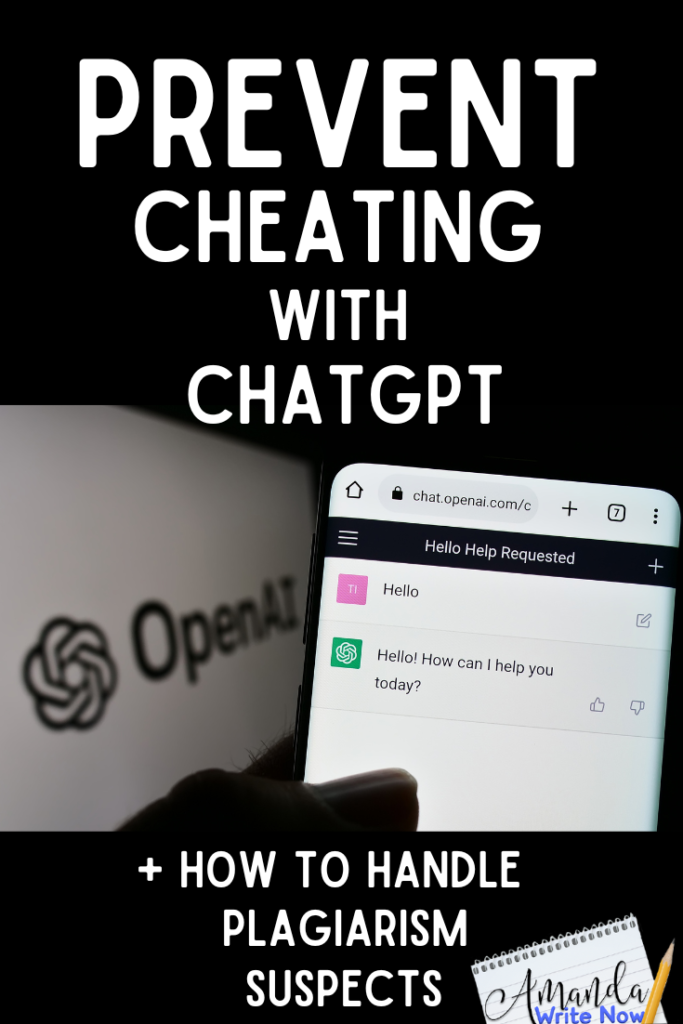


0 Comments